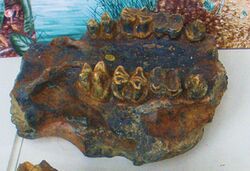Biology:Hexaprotodon
| Hexaprotodon | |
|---|---|

| |
| Hexaprotodon sivalensis skull elements | |
| Scientific classification | |
| Domain: | Eukaryota |
| Kingdom: | Animalia |
| Phylum: | Chordata |
| Class: | Mammalia |
| Order: | Artiodactyla |
| Family: | Hippopotamidae |
| Subfamily: | Hippopotaminae |
| Genus: | †Hexaprotodon Falconer & Cautley, 1836 |
| Type species | |
| †Hexaprotodon sivalensis Falconer & Cautley, 1836
| |
| Species | |
|
See text | |

Hexaprotodon is an extinct genus of hippopotamid known from Asia and possibly Africa. The name Hexaprotodon means "six front teeth" as some of the fossil forms have three pairs of incisors.[1][2]
The name Hexaprotodon was often applied to the pygmy hippopotamus before its reclassification into the genus Choeropsis. The genus sensu lato, including African taxa, has been suggested to be paraphyletic with respect to both species of living hippopotamus.[1] The uncontroversial, core Asian members of the genus most closely related to the type species H. sivalensis were widespread throughout the Late Neogene and Quaternary of South and Southeast Asia, with the oldest records coming from the Late Miocene Siwalik Hills. They were mostly extinct by the Late Middle Pleistocene in Southeast Asia[3] but survived in Sumatra into the early Late Pleistocene.[4] The last known populations survived on the Indian Subcontinent to the very end of the Pleistocene.[3]
Hexaprotodon survived in India until the terminal Pleistocene, with the latest dates being around 16,467–15,660 cal years Before Present from bones found in the Narmada River valley in central India. Fossil evidence from a late-surviving Indian Hexaprotodon indicates that it lived during a catastrophic drought caused by the latest Heinrich event, leading to an extremely weak Indian monsoon. It is thought that these drought conditions led to a heavy habitat fragmentation due to Hexaprotodon depending on aquatic habitats, prompting an extinction vortex. Humans may have also facilitated the extinction by hunting the hippopotamuses during this vulnerable state, although no evidence of hippopotamus butchery is known from the Indian subcontinent.[3]
Species
The genus Hexaprotodon contains the following species, all from Asia and Africa:
- Hexaprotodon bruneti (Boisserie and White, 2004)
- Hexaprotodon crusafonti (Aguirre, 1963)
- Hexaprotodon hipponensis (Gaudry, 1867)
- Hexaprotodon imagunculus (Hopwood, 1926)
- Hexaprotodon iravticus (Falconer and Cautley, 1847)
- Hexaprotodon karumensis (Coryndon, 1977)
- Hexaprotodon mingoz (Boisserie et al., 2003)
- Hexaprotodon namadicus (Falconer and Cautley, 1847 - possibly same as H. palaeindicus)
- Hexaprotodon palaeindicus (Falconer and Cautley, 1847)
- Hexaprotodon pantanellii (Joleaud, 1920)
- Hexaprotodon primaevus (Crusafont et al., 1964)
- Hexaprotodon protamphibius (Arambourg, 1944)
- Hexaprotodon siculus (Hooijer, 1946)
- Hexaprotodon sinhaleyus (Deraniyagala)
- Hexaprotodon sivajavanicus (Hooijer, 1950)
- Hexaprotodon sivalensis (Falconer and Cautley, 1836)
- Hexaprotodon sp. - Myanmar hippopotamus (fossil)

References
- ↑ 1.0 1.1 Boisserie, Jean-Renaud (2005). "The phylogeny and taxonomy of Hippopotamidae (Mammalia: Artiodactyla): a review based on morphology and cladistic analysis". Zoological Journal of the Linnean Society 143: 1–26. doi:10.1111/j.1096-3642.2004.00138.x.
- ↑ Hexaprotodon, The Paleobiology Database, läst 19 mars 2013.
- ↑ 3.0 3.1 3.2 Jukar, Advait M.; Patnaik, Rajeev; Chauhan, Parth R.; Li, Hong-Chun; Lin, Jih-Pai (September 2019). "The youngest occurrence of Hexaprotodon Falconer and Cautley, 1836 (Hippopotamidae, Mammalia) from South Asia with a discussion on its extinction" (in en). Quaternary International 528: 130–137. doi:10.1016/j.quaint.2019.01.005. Bibcode: 2019QuInt.528..130J.
- ↑ Smith, Holly E.; Price, Gilbert J.; Duval, Mathieu; Westaway, Kira; Zaim, Jahdi; Rizal, Yan; Aswan; Puspaningrum, Mika Rizki et al. (2021-11-30). "Taxonomy, taphonomy and chronology of the Pleistocene faunal assemblage at Ngalau Gupin cave, Sumatra" (in en). Quaternary International. Human Evolution in the Asia-Pacific Realm: Proceedings of the 1st Asia-Pacific Conference on Human Evolution 603: 40–63. doi:10.1016/j.quaint.2021.05.005. ISSN 1040-6182. https://www.sciencedirect.com/science/article/pii/S1040618221002901.
Wikidata ☰ Q2715758 entry

